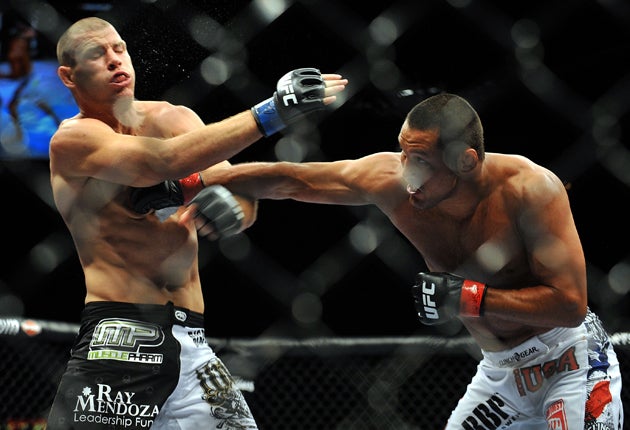A fresh chapter in the history book of British fighters whose grandest ambitions turn to dust in Las Vegas was written late on Saturday, when one of our nation’s most feted pugilists came, saw and was comprehensively conquered beneath the bright lights of his sport’s biggest stage.
More than 300 million, in 76 countries, watched a showdown that had transfixed prize-fighting’s first city, notching-up 1.2 million $45 pay-per-view sales in the US alone, and helping a pair of ringside tickets to the Mandalay Bay’s sold-out arena change hands for a recession-busting $45,000
Yet when the hopes of the travelling British fans were finally dashed, it wasn’t a plucky Ricky Hatton, or Frank Bruno, who was smeared indignantly across the canvas. And they weren’t looking out across one of the floodlight boxing rings that have for years hosted combat sport’s greatest match-ups.
Instead, the unfortunate fighter knocked clean out, one and a half rounds into the biggest fight of his career was a 29-year-old former carpet fitter from Clitheroe called Michael Bisping. And his scene of his demise was eight-sided cage described by the night’s theatrical announcer as The Octagon.
Bisping is our nation’s leading mixed martial artist. And on Saturday, his middleweight battle with Dan Henderson was one of the leading draws at UFC 100, a totemic milestone in the extraordinary evolution of "MMA" from blood-and-sawdust freak-show into a mainstream, blue-chip 21st century sport.
In a little over a decade, the pursuit once known as cage-fighting has morphed into a staggeringly-popular test of athleticism, skill and raw brutality. It marries the best of jiu-jitsu, Greco-Roman wrestling, taekwondo, kickboxing, and traditional boxing - and boasts hundreds of millions of devoted fans.
The sport’s rise has turned leading promoter UFC into a multinational company recently estimated by Forbes magazine to be worth $1 billion. It is now seen by many sporting pundits – who give it more space than boxing in some US newspapers – as a threat to the future of traditional pugilism.
TV audiences alone helped UFC make $200 million last year, and eight of the ten most watched pay-per-view events, in any sport, including boxing, were promoted by UFC. That's before you even consider advertising: lkast night’s event attracted blue chip sponsorship form firms like Budweiser and Harley Davidson, keen to tap into its edgy, young demographic.
The extraordinary growth has made millionaires of fighters like Bisping, who four years ago was sleeping in his car, as he criss-crossed Britain to fight, for tiny purses, at leisure centres and nightclubs in places like Eldon and Purfleet. Today, he is close to a household name in America, starring in reality TV shows, video games. His is even the subject of a replica doll.
Yet commercial success counts for nothing when you’re forced to go toe-to-toe over three five-minute rounds against a man with the reputation, experience, and raw ferocity of Henderson, a two-time former US Olympic Greco-Roman wrestler who is regarded as one of the legendary figures in mixed martial arts.
Bisping came into the bout with a career record of 17 wins and just one loss, but with a question mark over his ability to handle top calibre opponents. Victory would have teed-up a world middleweight title fight on his home turf of the MEN arena in Manchester, against Brazil’s Anderson Silva, widely regarded as the world’s best pound-for-pound fighter.
Bisping also came with a plan. He wanted to avoid being drawn into a wrestling match with Henderson, an acknowledged master of that art, and instead hide behind his precise left hand and nimble defensive work to jab his way to a points victory.
But from the opening bell he looked nervy and in danger of being swamped. And after taking a few ominous shots in the first round, he walked into a haymaker of a right hook that rendered him instantly unconscious after three minutes twenty seconds of the second.
It was followed, in the moments after he’d crashed to the blood-soaked canvas, with another right to the jaw, which had all of Henderson’s 185 pound bodyweight behind it. After the referee had stopped the fight, he lay on his back, immobile for a worrying two minutes.
Bisping ended the night being rushed to Valley hospital in Las Vegas for a CAT scan, and in some quarters, his opponent’s eagerness to deliver the potentially-dangerous and certainly un-necessary second blow attracted fierce criticism.
There’s no love lost between the two fighters, and Bisping's colourful jibes had succeded in publicly riling Henderson in the run-up to the fight. After his victory, the American fighter admitted: “I know when a fighter’s out. I knew he was out when I [first] hit him. That [second punch] one was just to shut him up a bit.”
Later, the stylish Canadian Georges St Pierre retained his welterweight title on points after a technical masterclass against Brazilian Thiago Alves. Brock Lesnar, a former WWE wrestler, demonstrated his mastery of the heavyweight division delivered a textbook display of savage thuggery to stop Frank Mir a minute and a half into the second round.
Subscribe to Independent Premium to bookmark this article
Want to bookmark your favourite articles and stories to read or reference later? Start your Independent Premium subscription today.


Join our commenting forum
Join thought-provoking conversations, follow other Independent readers and see their replies